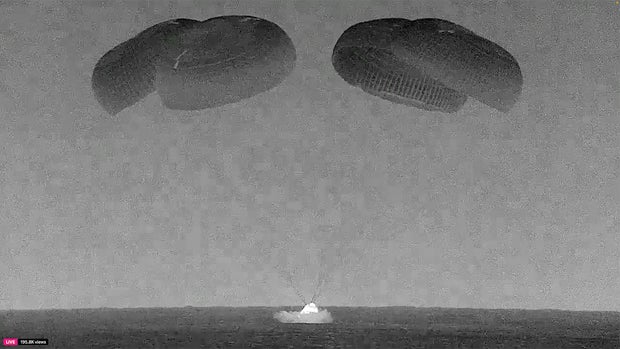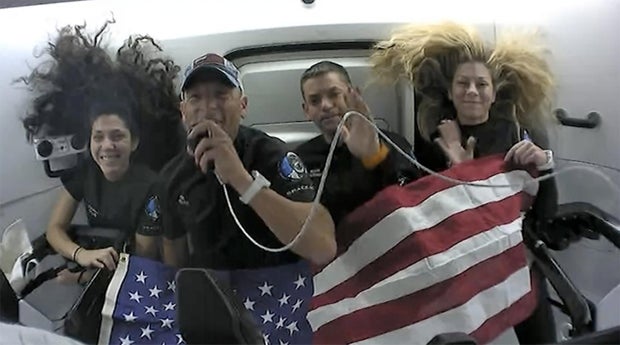After setting an altitude record and staging the first non-government spacewalk, billionaire Jared Isaacman and his three crewmates returned to Earth early Sunday, plunging back into the atmosphere aboard their Crew Dragon spacecraft for an on-target splashdown in the Gulf of Mexico.
With Isaacman and pilot Scott “Kidd” Poteet monitoring cockpit displays, flanked by SpaceX medical officer Anna Menon and crew trainer Sarah Gillis, the spacecraft slammed back into the discernible atmosphere and decelerated in a fireball of atmospheric friction, protected by a SpaceX-designed heat shield.
SpaceX
A few minutes later, the spacecraft’s parachutes unfurled and the Crew Dragon settled to a gentle 15-mph splashdown at 3:36 a.m. EDT near Dry Tortugas, about 70 miles from Key West, Florida.
Spectacular, if ghostly, infrared images of the spacecraft during re-entry were captured by a NASA photo-reconnaissance jet and then by an IR camera on a SpaceX recovery ship. Even the crew of the International Space Station got a chance to witness the spacecraft’s fiery re-entry.
“We actually had a pretty neat view of Polaris Dawn entering,” astronaut Mike Barratt radioed flight controllers in Houston. “All of us were more or less crowded in the (multi-window) cupola watching it. That was pretty spectacular for us.”
SpaceX
The SpaceX recovery ship was on the scene within about a half hour to haul the capsule on deck where support personnel were standing by to help the crew members out of the spacecraft. All four climbed out under their own power after five days in weightlessness, clearly elated and smiling broadly as they greeted the recovery crew.
After routine post-landing medical checks, Isaacman and his crewmates were expected to be flown ashore by helicopter followed by a flight back to the Kennedy Space Center for reunions with family and friends.
The Polaris Dawn mission, financed by Isaacman, in cooperation with SpaceX, was launched from the Kennedy Space Center atop a Falcon 9 rocket early Tuesday. Right off the bat, the crew set a new altitude record for a piloted spacecraft in Earth orbit, reaching a high point, or apogee, of 875 miles.
SpaceX
That’s farther from Earth than anyone has flown since the final Apollo voyage to the moon in 1972.
Early Thursday, the crew set another record when Isaacman and Gillis took turns floating just outside the capsule’s hatch in the first non-government spacewalk ever conducted.
“Back at home we all have a lot of work to do, but from here, Earth sure looks like a perfect world,” Isaacman marveled, taking in a spectacular view of the borderless planet below as he floated through the Crew Dragon’s hatch.
The goal of the brief excursions was to test the SpaceX-designed pressure suits in the harsh environment of space, assessing their mobility and checking the motion of wrist, elbow and shoulder joints to help engineers design improved versions for future flights to the moon and, eventually, Mars.
Along with a full slate of biomedical research, the crew also tested laser communications technology linking the Crew Dragon to the Starlink constellation of commercial internet relay satellites.
SpaceX
“Early this morning via @Starlink space lasers, the Polaris Dawn crew chatted with SpaceX teams over coffee and donuts,” SpaceX posted on X Saturday. “During the 40+ minute uninterrupted video call, Dragon completed half an orbit over the Eastern Seaboard of the U.S., cutting southeast over the Atlantic Ocean and rounding the Cape of Good Hope.”
Earlier in the mission, Gillis, an accomplished violist, participated in what amounted to an international concert, performing composer John Williams’ “Star Wars” song “Rey’s Theme,” accompanied by young musicians in the United States, Brazil, Venezuela, Haiti, Sweden and Uganda.
The Polaris Dawn mission is the first of three planned by Isaacman, an entrepreneur and philanthropist, in cooperation with Musk.
The second flight will be another Crew Dragon mission while the third will be the first piloted flight of SpaceX’s huge Super Heavy-Starship rocket, now under development in Texas.
It’s not known how much Isaacman is paying for the flights or how much SpaceX funded on its own.
Polaris Dawn is SpaceX’s fifth commercial Crew Dragon flight to orbit and its 14th including NASA missions carrying crew members to the International Space Station. The California rocket builder has now launched 54 men and women to orbit since piloted flights began in May 2020.





